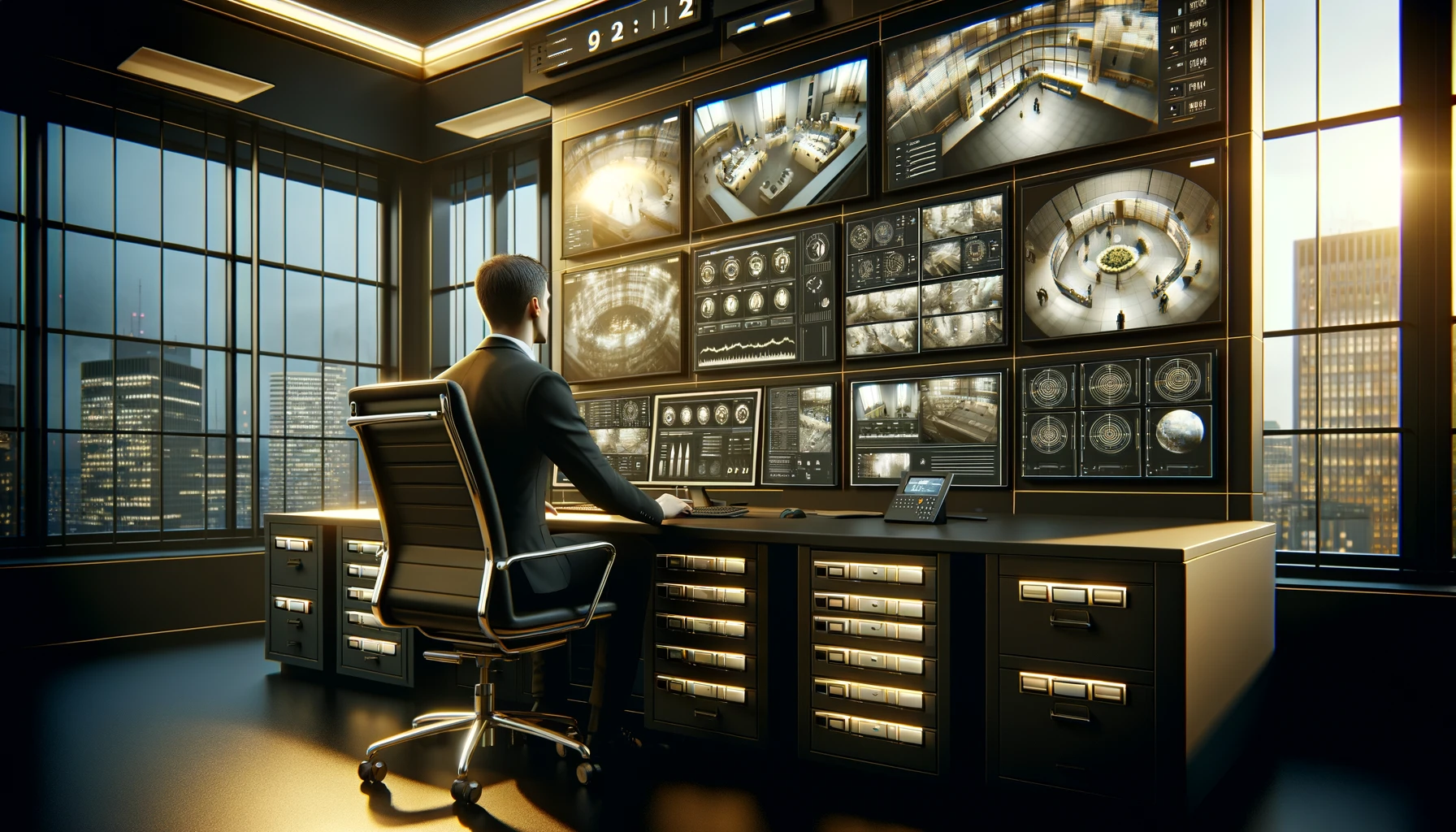In today's world, where the unexpected lurks around every corner, ensuring the security of your building isn't just a precaution—it's a necessity. Whether you're a property manager, a chief security officer, or a security company hiring manager, the safety of your premises, assets, and people rests in your hands. This comprehensive guide aims to walk you through essential security measures for buildings, focusing on access control and surveillance systems, all while keeping the tone light and the information digestible.
Introduction to Building Security
Building security encompasses a broad range of practices, technologies, and strategies designed to protect people, property, and assets from potential threats. These threats can range from unauthorized access and theft to vandalism and even terrorism. A robust security system is, therefore, multifaceted, combining physical security measures with advanced technological solutions.
Why Is Building Security Important?
-
Protects Assets: From valuable equipment to confidential data, buildings often house critical assets that require protection.
-
Ensures Safety: The well-being of occupants, visitors, and staff is paramount, and effective security measures help safeguard against harm.
-
Mitigates Risks: A well-secured building deters criminal activity and can significantly reduce the risk of theft, damage, and other security incidents.
-
Compliance: Certain industries have strict regulatory requirements for security, making comprehensive security measures not just advisable but mandatory.
Section 1: Understanding Access Control Systems
Access control systems are at the heart of building security, determining who is allowed to enter or exit, where they are allowed to exit or enter, and when they are allowed to do so. Let's delve into the essentials of access control.
Types of Access Control Systems
-
Discretionary Access Control (DAC): This system allows the owner or administrator to restrict access to certain areas. It's flexible but requires manual oversight.
-
Mandatory Access Control (MAC): Often used in high-security environments, MAC systems classify all end-users and provide access based on security clearance.
-
Role-Based Access Control (RBAC): Access is based on the user's role within the organization, automating access permissions and simplifying management.
Key Components
-
Electronic Locks: Replace traditional locks and keys with electronic locking mechanisms that can be controlled remotely.
-
Card Readers and Key Fobs: Devices used to grant access based on a swipe card or key fob presented by the user.
-
Biometric Systems: Use unique physical characteristics, such as fingerprints or facial recognition, to verify identity.
-
Access Control Panel: The central hub that connects and manages all access control devices, making decisions based on programmed settings.
Best Practices for Implementing Access Control
-
Conduct a Security Assessment: Identify sensitive areas and potential vulnerabilities to determine where access control is necessary.
-
Choose the Right System: Consider the level of security required, the size of the building, and the flow of traffic when selecting an access control system.
-
Regular Updates and Maintenance: Keep your system updated with the latest software and regularly check hardware components to ensure reliability.
Section 2: Maximizing Surveillance Systems
Surveillance systems act as the eyes of your security operation, providing real-time monitoring and recording capabilities that can deter crime and provide valuable evidence in the event of an incident.
Types of Surveillance Cameras
-
Dome Cameras: Discreet cameras ideal for indoor and outdoor use, offering a wide viewing angle.
-
Bullet Cameras: Long, cylindrical cameras best suited for specific areas, providing high-quality images over long distances.
-
PTZ (Pan-Tilt-Zoom) Cameras: Offer the ability to pan, tilt, and zoom, allowing operators to monitor large areas and focus on specific activities or subjects.
-
IP Cameras: Digital video cameras that can send and receive data via a network or the internet, offering remote access and high-definition clarity.
Implementing an Effective Surveillance System
-
Strategic Placement: Install cameras at entry and exit points, sensitive areas, and locations with high foot traffic to ensure comprehensive coverage.
-
Consider Lighting Conditions: Ensure areas under surveillance have adequate lighting for clear image capture, especially at night.
-
Regular Maintenance: Check camera functionality, clean lenses, and ensure recording devices are working correctly to prevent gaps in surveillance.
-
Privacy Compliance: Be mindful of privacy laws and regulations, ensuring that surveillance practices are compliant and respectful of individuals' privacy.
Section 3: Emergency Preparedness and Response
In the realm of building security, preparing for emergencies is as crucial as preventing them. An effective emergency preparedness plan ensures that when the unexpected occurs, your security team and building occupants are ready to respond appropriately.
Developing an Emergency Preparedness Plan
-
Risk Assessment: Begin by identifying potential emergencies that could impact your building, such as fires, natural disasters, or security breaches.
-
Evacuation Procedures: Establish clear evacuation routes and procedures. Regular drills should be conducted to ensure everyone knows how to exit the building safely during an emergency.
-
Communication Plan: Implement a system for alerting occupants of an emergency, providing instructions, and communicating with external emergency services.
-
Emergency Kits and Supplies: Maintain stocked emergency kits with first aid supplies, water, flashlights, and other essentials in accessible locations throughout the building.
-
Training: Regular training sessions for security staff and building occupants on how to respond to various emergency scenarios are vital.
Best Practices for Emergency Response
-
Regular Review and Update: Emergency plans should be reviewed and updated regularly to reflect any changes in building layout, occupancy, or emerging threats.
-
Leverage Technology: Utilize technology such as mass notification systems to enhance the effectiveness of your communication plan.
-
Collaborate with Local Authorities: Work closely with local emergency services to ensure your plans align and that they are familiar with your building's layout and procedures.
Section 4: Security Personnel Training and Management
The human element of building security cannot be overstated. Well-trained and effectively managed security personnel are invaluable assets in maintaining a secure environment.
Training Security Personnel
-
Basic Training: Should cover security fundamentals, including patrol techniques, observation skills, and report writing.
-
Specialized Training: Depending on the building's needs, security staff may require specialized or advanced training in areas such as access control systems, emergency response, or first aid.
-
Ongoing Education: Security threats evolve, and so should your team's knowledge. Regularly scheduled training sessions on new security technologies, trends, and threats are essential.
Managing Security Personnel
-
Clear Roles and Responsibilities: Each team member should have a clear understanding of their role and responsibilities within the security operation.
-
Performance Monitoring: Implement a system for monitoring and evaluating the performance of security personnel, including regular feedback and reviews.
-
Wellness and Support: Security work can be stressful. Providing support for mental and physical well-being can help maintain a motivated and focused team and help prevent security guard burnout.
Section 5: Integrating Technology with Human Oversight
The most effective building security strategies blend technology with human oversight. While technology can monitor and control access and provide surveillance, human intuition and judgment play crucial roles in identifying and responding to threats.
Strategies for Integration
-
Leverage Surveillance with Patrols: Use surveillance systems to direct patrol officers to areas of interest or concern, enhancing their effectiveness.
-
Access Control Oversight: While electronic access control systems manage entry points, security personnel can provide additional verification and manage exceptions.
-
Emergency Response Coordination: During an emergency, technology can provide critical information, but it's the trained security personnel who execute the response plan.
Best Practices
-
Regular System Checks: Ensure that security technology and systems are regularly checked and maintained to function correctly when needed.
-
Training on Technology: Security personnel should be trained not just in security practices but in the operation and response to the technology deployed within the building.
-
Scenario-Based Drills: Conduct drills that simulate real-life scenarios where technology and personnel must work together seamlessly to respond to threats.
Building security is a multifaceted challenge that requires a comprehensive approach. By focusing on access control, surveillance, emergency preparedness, personnel training, and the integration of technology with human oversight, you can create a robust security posture that protects against a wide range of threats. Remember, the goal is to create not just a secure environment but a culture of security where technology, personnel, and procedures work in harmony to safeguard assets, property, and lives.
With this guide, property managers, chief security officers, and security company hiring managers have a blueprint for developing and enhancing their building security strategies. Stay vigilant, stay informed, and most importantly, stay committed to the safety and security of your premises.
.png)
.png)
.png)

.png)
.png)

.png)
.png)
.png)
.png)
